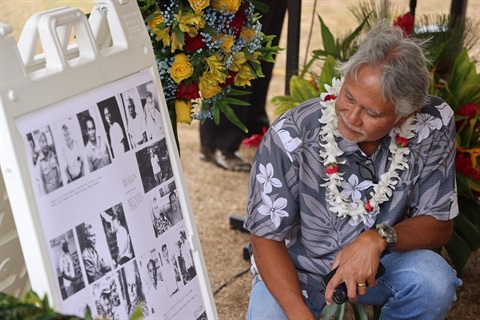100th anniversary of the Hanapepe Massacre commemorated Monday
Published on September 10, 2024

HANAPĒPĒ – The County of Kaua‘i Planning Department held a special ceremony on Monday, commemorating the centennial anniversary of the Hanapēpē Massacre of 1924, which is remembered as a key moment in the history of labor movements in Hawai‘i.
The ceremony was attended by nearly 150 people including government officials and dignitaries, community members, volunteers, and descendants of those involved 100 years ago.
Monday’s ceremony began with a blessing by Deacon Bambi Emayo, followed by opening remarks from Mayor Derek S.K. Kawakami.
“The Hanapēpē Massacre of 1924 is a story that many of us are not familiar with, but truthfully, it’s a story that should never be forgotten,” said Mayor Kawakami. “As we bring to light what happened here 100 years ago, and recognize its significance, our hope is to remember a pivotal part of Hawai‘i’s labor history while reflecting on what our people and culture have overcome. We thank all involved in today’s ceremony for helping us to remember the sacrifices made that day and beyond.”
The program continued with remarks from State Representative Dee Morikawa and Kaua‘i County Council Chair Mel Rapozo. Members of the community also spoke at the event, including Michael Miranda, Adam Jansen of Hawai‘i State Archives, and Chad Taniguchi, former Director of the Center for Oral History at the University of Hawaiʻi at Mānoa Department of Ethnic Studies.
“The 1924 strike by mostly Visayan Filipino workers was a ‘just cause’ for better pay and better working conditions,” said Taniguchi. “Too often we take for granted an 8-hour day and minimum wage laws. Our close-knit island community is grateful for the contributions and sacrifices of all the people who have come to call Hawaiʻi home. We must not forget our shared history. All those who died in 1924 were human beings with precious lives that were lost.”
In addition to commemorating the Hanapēpē Massacre, Planning officials also noted efforts underway from the county’s Public Access, Open Spaces, and Natural Resources Preservation Fund Commission who is currently trying to acquire two parcels associated with the Hanapēpē Massacre, for its historical and cultural significance. The parcels are near to where the battle began, and the Commission and the County of Kaua‘i Planning Department are currently in negotiations with the landowner. The Open Space Commission unanimously voted to acquire both Hanapēpē parcels on May 16, 2024. On July 31, 2024, the Kaua‘i County Council approved two bills to expend up to $1,444,000 from the Public Access, Open Space, Natural Resources Preservation Fund for the acquisition.
About the Hanapēpē Massacre of 1924:
On September 8, 1924, during a territory-wide Filipino sugar plantation strike, two non-striking Ilocano workers from Makaweli Plantation biked into Hanapēpē to buy shoes. They were captured by the Visayan strikers and held at the strike camp located at the Japanese Language School. West Kauaʻi Sheriff William Crowell was notified but was unsuccessful in getting the two non-strikers released.
On September 9, 1924, Sheriff Crowell along with armed special police arrived at the strike headquarters with two warrants to “arrest” the captured men as a legal means to retrieve them. The two men were turned over to the police, but the strikers followed them to their cars located a half-mile away from the Japanese Language School, near Moi Road. A confrontation ensued between the strikers and police and the situation escalated quickly. The confrontation led to violence between the police and strikers along the government road and near the banana patch, resulting in the death of 16 Filipino strikers (15 were plantation workers of Visayan ancestry and one was from the Ilocos provinces), and four policemen, three Hawaiian and one Chinese, along with many others injured.
After the tragic event, the National Guard was sent to Kaua‘i to restore order. Over one hundred strikers were arrested. Seventy-six Filipinos were indicted for rioting, and 58 pled guilty and received four years in prison. With their leaders in jail, the 1924 strike dissipated after eight months and the labor movement stagnated for another 10 years. Progress finally came after numerous strikes between 1937 and 1958. The idea of an industry-wide, interracial union took root and the International Longshoremen and Warehouse Union (ILWU) was formed, which became a political and economic force that continued advocating for worker’s rights.
Filipinos made great sacrifices and led the struggle of Hawai‘i’s working class for better working conditions. Between 1920 and 1940, Filipinos organized 12 strikes against the plantations. The Hanapēpē Massacre of 1924 is remembered as a tragic moment in the history of labor movements in Hawai‘i, a flashpoint, but not representative of the labor movement. In the 1940s and 1950s effective unions gained workers a fairer share for their labor. Plantations and workers prospered in the 1960s and 1970s because of productive union/management negotiations. The importance of unions remain evident today as unions continue to fight for livable wages, safe working conditions, and fair labor practices.
For more information about the Hanapēpē Massacre of 1924 or on the County of Kaua‘i’s Hanapēpē Parcel Acquisitions, please visit the Public Access, Open Space, Natural Resources Preservation Fund Commission’s website: https://www.kauai.gov/Government/Boards-and-Commissions/Public-Access-Open-Space-Natural-Resources-Preservation-Fund-Commission.

From left to right: Errol Ceballos - son of Francisco and Lucy Ceballos, Greg Auberry - Consuelo Foundation President & CEO, Open Space Commissioner Robin Pratt, Kahu Deacon Bambi Emayo, Ron Sakamoto, Ale Lomosad, Michael Miranda, Tina Sakamoto, Marc Inouye of Par Hawai‘i LLC, Dorothy “Kako” Hayashi, Chad Taniguchi - former Director of the Center for Oral History at the University of Hawaiʻi at Mānoa Department of Ethnic Studies, Mayor Derek S.K. Kawakami, Council Vice Chair KipuKai Kualii, Councilmember Felicia Cowden, Councilmember Bernard Carvalho Jr., Deputy Planning Director Jodi Higuchi Sayegusa, Council Chair Mel Rapozo, Clayton Dela Cruz of ILWU, Trinette Parraga Kaui, Randall Francisco, Sherri Amimoto, and Planning Director Ka‘āina Hull.










###